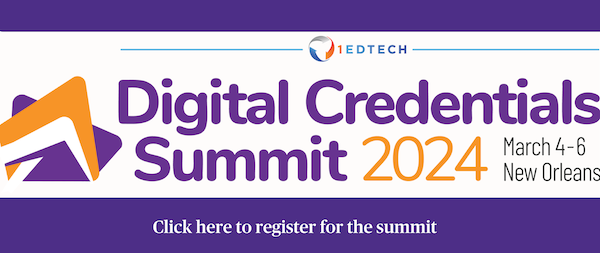Published on
The On-Ramp to Scaling Microcredentials: Advice from the Acceleration Lane

Depending where your institution seems to be along the continuum—from offering just a few microcredentials to offering many—there are some things to keep in mind if you want to achieve large scale with these types of offerings. Every institution is different, but there are some common principles that can determine how this sort of transformation will evolve. So, as you turn onto the entrance ramp, destined for a significant offering of microcredentials at scale, let’s review a few approaches that can help you pick up speed.
Every successful entrepreneur will tell you that starting an operation is nothing like elevating it to scale once it has been established. Everything changes, and the organization must transform. Recent information from everywhere in our field has conveyed the message that microcredentials are a wave we need to catch and ride. But even if we want to catch it, we may be sitting on infrastructure that will literally crumble when we make the attempt. Having done such things in both corporate and academic environments, I have recognized that there are patterns for success we can use to our advantage.
One such approach at the top of my list is the mindset of scale—the understanding that eventually you will be serving thousands of learners taking perhaps hundreds of microcredential offerings. This mindset makes all the difference when you evaluate your workflow, procedures, infrastructure, staff, marketing and communications practices.
No one instantly creates such an end point, you need to be asking yourself the right questions at every step along the way. What if I needed to put 1000 learners through this approach in less than a month? How would that work, and would this process even be sustainable at that rate? Each element of workflow needs to be evaluated in this way, from advertising, website design, learner inquiry and evaluation, to computer systems, enrollment management, recordkeeping and reporting. Track each workflow through its stages. Find out just how long it takes, how many people are involved, how likely mistakes will be made, how frequently confusion can result or how often learners just give up in frustration and go somewhere else for their microcredential. Multiply every one of these parameters by 1000, and you’ll have a good picture of what scale will look like if you keep everything the way it is.
When one of our first expensive retreat offerings resulted in learners spending the first session complaining to the instructor about how bad things went for them just to get enrolled, I treated it as a flashing neon sign that things needed to change. From that point, we adopted the mindset of scale and started designing everything for large-scale operation throughout the entire learner lifecycle.
Most of us operate with tight constraints and limited resources, so once we recognize all this need for change, where do we get the resources to build such a microcredential mega-machine? That brings us to the next most important concept: Permissions and resources aren’t gained just by submitting a visionary proposal but through leadership recognizing their necessity. Investors don’t invest in a venture unless they see the need for it, which can cause the entrepreneur’s nightmare: “How do I convince those with the cash to make it available for me to build the enterprise, when they hold back until they can see actual progress being made?” Despite how it may seem, it isn’t a hopeless spiral. Instead, it calls us to be both inventive and convincing.
Before you spend even one dollar, you need to assemble your network. Who in your institution is already doing something similar with microcredentials? They may not use that term, and they may not have any idea that this is what they are doing, but they’re out there. And you need to locate them and talk with them. As an undergrad student of cultural anthropology, I became aware of a very important principle: the psychic unity of humankind. This principle states simply that people will tend to react in a similar way to a similar stimulus. Multiple inventors have been identified for many key inventions throughout history.
The need existed, so multiple people sought a resolution—even if we credited just one person for the final achievement. In relation to our context here, you need to assume that others see the same possibilities you do and that they have likely found the same barriers to progress. If you can locate these people in different departments or organizational units, then you can understand what they have experienced or the solutions they have attempted. By finding them and bringing them together, you’ll probably learn that all are experiencing similar problems, operating under similar constraints and wishing that someone, somehow, would help them figure out a better way.
Some institutions have organized these folks into committees from the top. It has been my experience that innovation comes from listening to those closest to the problem in an environment where they can feel free to share their frustrations. Even if you need to do so off the radar, get out there and reach the point where you really understand what everyone needs. That will help everyone envision with you what would work best at scale.
This effort took me the better part of a year, but two very valuable results came from it. First, I better understood what scale would really look like at our institution, as well as the resources it might require. Second, each of us became more inspired to reach for the needed solutions together as a group. That, in turn, created the most important ingredient to allow future permissions and resources to be released: leadership’s recognition of necessity at scale!
So, you’ve adopted a mindset of scale and assembled a group of like-minded individuals prepared to make things better together, representing necessity at scale. Now, how do you create the rising tide that will float all your boats?
Rising tides represent change, and organizations tend to resist change. Why? Organizations are groups of people who have structured themselves to achieve a common purpose together. In order to stay focused on that purpose, organizations tend to protect themselves against things that might act as distractions. So, procedures, systems, policies, governance and permissions are all developed to help an organization focus on the main purpose that unites it. Presto! You have resistance to change! Don’t see resistance to change as bad; it is a positive force that helps maintain an organization’s focus.
The issue really is that organizations can be so focused on a given purpose that they lose sight of the changing environment around them, miss signals that could trigger a more appropriate focus. So, what do we do if an individual needs to react to new signals? We educate them, giving them the tools they need to thrive in a changing world, while providing them the incentive to adopt these new tools and develop a new focus. Organizations need the same effort, involving a series of techniques that can help to bring about organizational change.
You can get degrees in organizational behavior and change but the effort to scale microcredentials can focus on a few simple concepts:
There must be an incentive for the organization to change in order to scale—what I like to think of as an organizational deal. What will be the organization’s reward for providing the needed resources and permission to change so it can offer microcredentials at scale? Every change effort must come up with this pronouncement of value: a return on investment, a reward for the disruption, a basic answer to the question, “What’s in it for us?”
It isn’t self-evident. You need to work with your group of like-minded change enthusiasts have some conversations with institutional leadership, so you can finally come up with the organizational deal that will trigger action. In our case, the organization’s current systems and procedures for non-credit offerings could not scale, which resulted in the invention of a myriad of disparate approaches across the institution.
This situation negatively affected several things that are core to our focus as an institution of higher learning. One key gap was that we didn’t know how many learners were taking how many microcredentials of what kind from which sections of the university and gaining what advantages from them. That certainly runs contrary to any organization with the purpose of educating people!
Putting it in another context: Imagine if the CEO of General Motors asked, “How many Chevrolet SUVs did we manufacture last year?” and the company couldn’t provide an answer. For us, if we imagined an increase in scale, perhaps to geometric levels, we could also imagine that this one question would become even more impossible to answer. So, that became what we offered as our organizational deal: Help us right the process, and we’ll unite under that new process to answer this critical question accurately, even while we scale everything up. The deal was accepted, and we were on our way.
You must recognize that this is not a linear process. You can set targets, define deliverables, create schedules, identify needed resources and convene presentations and meetings. Having taught project management for over 20 years, I know these are all good practices for managing a change effort. However, having led many such efforts over a similar span of time, I found out early on that you must not only have a contingency plan but you must consider having multiple levels of contingency plans.
What results is really an adaptive project plan. Such a plan does not manage toward future dates, it manages toward future states, recognizing that even these might need to change as progress picks up speed. There is a science to adaptive project management, and there is an art to implementing this science within any specific institution. Be ready to adapt as you discover new information or uncover surprising challenges. Involve key stakeholders that represent the systems, procedures, policies, personnel and practices that will need to change. Find out options, prioritize them, then work out how they might also need to evolve, implementing one way at one stage, then another way at a future stage. This flexibility will get you there. It is the key reason we all survived over so many millennia; we flexed and adapted with every bump along the way.
I will offer one last piece of advice that will help you bring all this together: Find out the facts, consider the options, involve stakeholders, create a common vision, develop ways to achieve that vision—all these things are important. But one thing will make it work. You need to lead! You will take the hits, and you will bear the brunt of the resistance—that is the nature of this role. If the vision of offering microcredentials at scale is a vision you can own, then show your passion to the organization, inspiring others to help you achieve that vision, both with them and for them. After all, investors want an entrepreneur who is not only passionate about making a vision into reality but who also leads the organization through the necessary transformation to reach performance at scale. Show your leadership that you have the passion, then make it possible for them to share it with you.
Go for it, and all the best for your journey!

Author Perspective: Administrator



